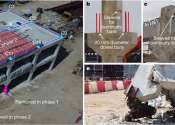Study highlights significant design advances across floating offshore wind sector
The UK's renewable energy sector is well placed to take advantage of the expected boom in floating offshore wind technology, a new study suggests.
Sep 8, 2023
0
1
Engineering

The UK's renewable energy sector is well placed to take advantage of the expected boom in floating offshore wind technology, a new study suggests.
Sep 8, 2023
0
1
Consumer & Gadgets

Being wowed by powerful graphics is not enough for a person to feel fully immersed in a virtual-reality (VR) world—a strong emotional response to the simulated environment is essential too, according to a new study from ...
Dec 11, 2023
0
54
Engineering

Engineers need to get more creative in their approach to design and additive manufacturing (AM) systems, by taking inspiration from the way humans grow and develop, say researchers at the University of Birmingham.
Jan 10, 2020
0
2
Hi Tech & Innovation

With two-thirds of a global population of 9.4 billion people expected to live in urban areas by 2050, we can expect a change in the domestic living arrangements we are familiar with today.
Sep 25, 2019
0
9
Engineering

Biogas plants produce methane from agricultural residues. This energy carrier is then mostly stored in membrane gas holders. In Germany, however, these storage systems are often outdated. Via leaks, methane is released into ...
Jun 9, 2020
0
21
Energy & Green Tech

Petrochemicals, the oil- and gas-derived compounds that serve as the molecular backbones for much of modern commerce, commanded a $539.3 billion market value in 2018.
Apr 30, 2019
0
12
Electronics & Semiconductors

With the outsourcing of microchip design and fabrication worldwide, a $350 billion business, bad actors along the supply chain have many opportunities to install malicious circuitry in chips. These "Trojan horses" look harmless ...
Aug 23, 2016
0
2
Engineering

Current building design methods are primarily based on improving the connectivity between components of the structure. In the event of component failure, this connectivity allows the loads that were carried by failed components ...
May 15, 2024
0
42
Internet

Shortly after Elon Musk took control of Twitter, some conservative personalities wasted no time to jump on the platform and recirculate long-debunked conspiracy theories in a tongue-in-cheek attempt to "test" whether Twitter's ...
Oct 29, 2022
0
13
Engineering

Engineers and technicians at the National Institute of Standards and Technology (NIST) spent months meticulously recreating the long concrete floors supported by steel beams commonly found in high-rise office buildings, only ...
Mar 24, 2020
0
5
A designer is a person who designs. More formally, a designer is an agent that "specifies the structural properties of a design object". In practice, anyone who creates tangible or intangible objects, such as consumer products, processes, laws, games and graphics, is referred to as a designer.
Classically, the main areas of design were only painting, sculpture and architecture, which were understood as the major arts. The design of clothing, furniture and other common artifacts were left mostly to tradition or artisans specializing in hand making them.
With the increasing complexity of today’s society, and due to the needs of mass production where more time is usually associated with more cost, the production methods became more complex and with them the way designs and their production is created. The classical areas are now subdivided in smaller and more specialized domains of design (landscape design, urban design, exterior design, interior design, industrial design, furniture design, cloth design, and many more) according to the product designed or perhaps its means of production.
The education, experience and genetic blocks that form the base of a competent designer is normally similar no matter the area of specialization, only in a later stages of training and work will designer diverge to a specialized field. The methods of teaching or the program and theories followed vary according to schools and field of study. Today, a design team, no matter the scale of the equipment, is usually composed by a master designer (the head of the team) that will have the responsibility to take decisions about the way the creative process should evolve, and a number of technical designers (the hands of the team) specialized in diverse areas according to the product proposed. For more complex products, the team will also be composed of professionals from other areas like engineers, advertising specialists, and others as required. The relationships established between team members will vary according proposed product, the processes of production, the equipment available, or the theories followed during the idea development, but normally they are not too restrictive, giving an opportunity to everyone in the team to take a part in the creation process or at least to express an idea.
This text uses material from Wikipedia, licensed under CC BY-SA